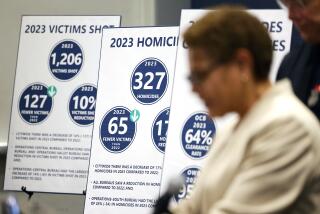Hope on the Domestic Front
- Share via
From the front lines of the war against a very domestic form of terrorism comes encouraging news--and hard-won lessons. Homicides between spouses are close to a 25-year low. Unlike other crimes, domestic violence doesn’t typically fluctuate with demographic changes or shifts in the economy. The steady decline over the past decades must be attributed to something else.
Call it constant vigilance. Thirty years ago, the accepted approach to domestic violence was to pretend it didn’t exist. If it spilled over into public view, friends and neighbors did their embarrassed best not to notice. Police officers called to a home simply tried to quiet things down. Judges--if a complaint got that far--were known to order couples to make up.
In the late 1970s, domestic homicides numbered more than 2,000 a year. Last year, about 900 people were killed by spouses, according to a U.S. Department of Justice survey.
Activists have worked diligently to pass laws, train police, establish hotlines, build shelters and raise awareness that domestic violence is a crime. Social scientists say these efforts, along with societal changes such as increased acceptability of divorce and more job opportunities for women, have worked.
Domestic violence activists themselves warn against a premature declaration of victory, in part for fear of weakening the public resolve they’ve worked so hard to build. They know better than most that this is a war of containment, a chronic disease that must be managed but can’t be cured. Nine hundred deaths are 900 too many. And the most dramatic decline has been in the number of men killed by their wives or girlfriends, which was lower to begin with. It turns out that cases in which abused women kill their partners have dropped as other escape hatches, from shelters to divorce, have opened.
Activists are especially concerned about women who come to the United States from cultures where wife-beating is still acceptable and where women have few opportunities outside of the home. Language and custom barriers and, for some, illegal immigrant status make seeking help all the harder.
However, help is there. Intervention works. A scourge once considered intractable can be curbed. It takes commitment, continued innovation, hard work and time. That is the hard lesson, but it is also the hope.
More to Read
Sign up for Essential California
The most important California stories and recommendations in your inbox every morning.
You may occasionally receive promotional content from the Los Angeles Times.













